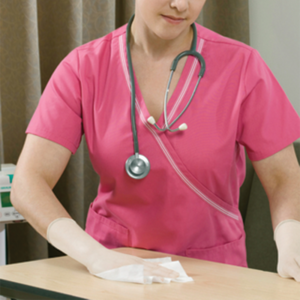Interventional Care


We notice that you are visiting us from . This site only services US-based visitors. Would you like to visit the site that is appropriate for your location?

For about a decade, prior to the pandemic, there was a shift towards the control of healthcare-associated infections (HAIs) through a focus on environmental cleaning, especially in relation to reusable medical equipment. The novel idea of continuous room disinfection was an ongoing topic of discussion among environmental experts and seemed an unattainable pipe dream.
Even with optimal cleaning and disinfecting practices, recontamination of the environment and equipment occurs quickly, especially in healthcare settings (1). Lots of ideas were bandied about, such as antimicrobial paint, spray systems, novel metal coatings, ongoing light-emitting systems, and so on and so forth. However, nothing seemed to reasonably meet the dream of achieving sustained antimicrobial activity for 24 hours, even when a surface is subsequently touched and used afterward.
With the pandemic onset, transmission prevention efforts became front and center, but trying to obtain PPE and cleaning and disinfection supplies was a major problem for both the healthcare and community settings. The worldwide demand for supplies far outpaced the production capabilities that existed, and many countries were no longer exporting the critical components that made up many of these products. If the novel idea of a disinfectant that gave persistent antimicrobial activity on surfaces for 24 hours had been readily available in all settings, would that have made a difference?
A novel 24-hour persistent disinfectant was developed and available on the market at the start of the pandemic, but the technology was so new, and disinfectant supplies were in such high demand, very few could get a hold of the product. Now that infection prevention products are more readily available, and it seems that Coronavirus may be here to stay, how can this technology help mitigate the risk of transmission of pathogens going forward?
First, we must understand what this disinfectant technology actually achieves. This novel CAD is the first and only EPA-registered surface disinfectant with 24 hours of sustained antimicrobial activity. But how does it work? The power behind CAD is a multi-layer protective “shield” on the surface. It can be used as a disinfectant providing 24-hour protection, a regular disinfectant, a soft surface sanitizer, and 7-day mildew and fungal preventative that is compatible with most surfaces–making it truly a versatile product for many situations. A multi-layer shield with a proprietary polymer binds the pathogen-fighting ingredient to the surface, even when the surface is subsequently touched and contacted multiple times.
In a paper titled “Antimicrobial activity of a continuously active disinfectant against healthcare pathogens” published in ICHE in 2019, Dr. William Rutala and colleagues evaluated the CAD technology in the healthcare setting and found that the novel disinfectant achieved “significant, sustained antimicrobial activity in 5 minutes against most pathogens after 24 hours of “wear” and reinoculations” (2). They concluded this technology is poised to be a significant contributor to the reduction of HAIs in the future and propose that “If the microbial load on surfaces is pathogen–free or if pathogens are substantially reduced, the treated surface will not act as a reservoir for pathogens and, thus, will not be linked to disease transmission. Thus, CAD … (and other continuous room decontamination technologies) may reduce or eliminate the problem of recontamination and minimize the role of contaminated environmental surfaces and equipment in the transmission of healthcare pathogens” (2).
It is no secret that the environment plays a role in the transmission of healthcare-associated pathogens via surfaces and the hands of healthcare workers (2). Therefore, having a technology that ensures a surface or piece of equipment does not become re-contaminated will be a game-changer in the world of surface disinfection.
Continuously active disinfectants will also significantly improve the efficiency of staff and healthcare personnel responsible for cleaning and disinfecting reusable patient care equipment if an application is only needed once every 24 hours. In addition, this persistent decontamination technology may reduce or eliminate the problem of recontamination and minimize the role of contaminated environmental surfaces and equipment in transmitting healthcare pathogens.
References